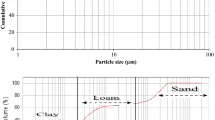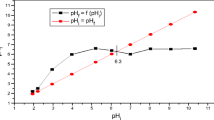Abstract
Crude kaolinite-glauconite clay was active with hydrochloric acid for various times under variable microwave irradiation power. The influence of activation parameters (power and/or time) on the structural and textural properties of the treated samples has been studied. The modifications were evaluated by XRD, FTIR, XRF, SEM, BET, grain size and zettametry. The XRD and IR results show that acid activation reveals only weak changes on crystallinity of samples. However, HCl activation of clay assisted by microwave modifies morphology and size of grains with a little variation of the specific surface area values. The adsorbing power of the raw and activated clay was tested with methyl orange dye and the adsorption isotherms were modeled using Langmuir and Freundlich models. This study showed that the maximum adsorbed quantity of dye passes from 3.21 mg/g for the untreated raw clay to 4.29 mg/g for the activated clay irradiated 2 min under microwave at a power of 900 W and that the Langmuir model is the most adequate to describe the adsorption process.
Graphical Abstract

Similar content being viewed by others
Data Availability
All data and materials are availables.
References
Yang Yin C, Aroua MK, Ashri WM, Daud W (2007) Review of modifications of activated carbon for enhancing contaminant uptakes from aqueous solutions. Sep Purif Technol 52(3):403–415. https://doi.org/10.1016/j.seppur.2006.06.009
Bhatnagar A, Hogland W, Marques M, Sillanpaa M (2013) An overview of the modification methods of activated carbon for its water treatment applications. Chem Eng J 219:499–511. https://doi.org/10.1016/j.cej.2012.12.038
Espana VAA, Sarkar B, Biswas B, Rusmin R, Naidu R (2016) Environmental applications of thermally modified and acid activated clay minerals: Current status of the art. Environ Technol Innov. https://doi.org/10.1016/j.eti.2016.11.005
Gupta VK, Carrott PJM, Ribeiro Carrott MML (2009)Low-cost adsorbents: Growing approach to waste water treatment a review critical. Rev Environ Sci Technol 39(10):783–842. https://doi.org/10.1080/10643380801977610
Gammoudi S, Srasra E (2019) Adsorption of organic dyes by HDPy+- modified clay: Effect of molecular structure on the adsorption. J Mol Struct 1193:522–531. https://doi.org/10.1016/j.molstruc.2019.05.055
Horri N, Sanz-Perez E S, Arencibia A, Sanz R, Frini-Srasra N, Srasra E (2020) Effect of acid activation on the CO2 adsorption capacity of montmorillonite. Adsorption. https://doi.org/10.1007/s10450-020-00200-z
Sobeih MM, El-Shahat MF, Osman A, Zaid MA, Nassar MY (2020) Glauconite clay-functionalized chitosan nanocomposites for efficient adsorptive removal of fluoride ions from polluted aqueous solutions. RSC Adv 10:25567–25585. https://doi.org/10.1039/D0RA02340J
Harrou A, Gharibi E, Nasri H, El Ouahabi M (2020) Thermodynamics and kinetics of the removal of methylene blue from aqueous solution by raw kaolin. SN Appl Sci 2:277. https://doi.org/10.1007/s42452-020-2067-y
Amar A, Loulidi I, Kali A, Boukhlifi F, Hadey C, Jabri M (2021) Physicochemical characterization of regional clay: Application to phenol adsorption. Appl Environ Soil Science. https://doi.org/10.1155/2021/8826063
McRae SG (1972) Glauconite. Earth Sci Rev 8(4):397–440. https://doi.org/10.1016/0012-8252(72)90063-3
Huggett JM (2013) Minerals: Glauconites and green clays reference module in earth systems and environmental sciences. https://doi.org/10.1016/B978-0-12-409548-9.02893-1
Singla R, Alex TC, Kumar R (2019) On mechanical activation of glauconite: physico-chemical changes, alterations in cation exchange capacity and mechanisms. Powder Technol. https://doi.org/10.1016/j.powtec.2019.10.035
Surendra BS, Veerabhadraswamy M, Nagaswarupa HP, Kumar HGA, Kendagannaswamy BK, Prashanth SC (2017) Microwave assisted physico-chemical modification of Bentonite clay: characterization and photocatalytic activity. Mater Today: Proc 4:11727–11736. https://doi.org/10.1016/j.matpr.2017.09.089
Frini-Srasra N, Srasra E (2008) Effect of heating on palygorskite and acid treated palygorskite properties. Surf Eng Appl Electrochem 44:43–49. https://doi.org/10.3103/s1068375508010092
Khabbouchi M, Hosni K, Mezni M, Srasra E (2019). Structural characterizations and mechanical behavior of activated clay-based Si5(PO4)6O and SiP2O7 compounds. Silicon. https://doi.org/10.1007/s12633-019-00218-1
Cherifi Z, Boukoussa B, Zaoui A, Belbachir M, Meghabar R (2018) Structural, morphological and thermal properties of nanocomposites poly(GMA)/clay prepared by ultrasound and in-situ polymerization. Ultrason Sonochem. https://doi.org/10.1016/j.ultsonch.2018.05.027
Teğin I, Saka C (2021) Chemical and thermal activation of clay sample for improvement adsorption capacity of methylene blue. Int J Environ Anal Chem. https://doi.org/10.1080/03067319.2021.1928105
Srasra E, Trabelsi-Ayadi M (2000) Textural properties of acid activated glauconite. Appl Clay Sci. 17:71–84
Frini-Srasra N, Srasra E (2010) Acid treatment of southTunisian palygorskite: Removal of Cd(II) from aqueous and phosphoric acid solutions. Desalination 250:26–34. https://doi.org/10.1016/j.desal.2009.01.043
Korichi S, Elias A, Mefti A (2009) Characterization of smectite after acid activation with microwave irradiation. Appl Clay Sci. 42:432–438. https://doi.org/10.1016/j.clay.2008.04.014
Pozo-Rodríguez M, Pardo-Canales L, Essih S, Cecilia JA, Dominguez-Maqueda M, Olmo-Sanchez MI, Franco F (2020) Modification of the textural properties of palygorskite through microwave assisted acid treatment. Influence of the octahedral sheet composition. Appl Clay Sci. 196:105745. https://doi.org/10.1016/j.micromeso.2019.109749
Nazarov VA, Sineltsev AA, Zelenova AN, Rybkov VS, Zelenov VA (2018) Improvement of fertilizing properties of glauconite under microwave radiation. J Eng Appl Sci 13(4):1304–1310
Bradley WD (1940) The structural scheme of attapulgite. Am Mineral 25:405–410
Khabbouchi M, Hosni K, Mezni M, Zanelli C, Doggy M, Dondi M, Srasra E (2017) Interaction of metakaolin-phosphoric acid and their structural evolution at high temperature. Appl Clay Sci 146:510–516. https://doi.org/10.1016/j.clay.2017.07.006
Selim KA, Youssef MA, Abdel Rahiem FH, Hassan MS (2014) Dye removal using some surface modified silicate minerals. Int J Min Sci Technol 24(2):183–189. https://doi.org/10.1016/j.ijmst.2014.01.007
Gastuche MC, Fripiat JJ (1962) Acid dissolution techniques applied to the determination of the structure of clay and controlled by physical methods. Sci Ceram 1:121–138
Robert CW (1984) Hand book of chemistry and physics, 65th edn. CRC Press, Boca Raton
Deming BS, Deming LS, Teller WSR (1940) J Am Chem Soc 62:1723
Gregg SJ, Sing KSW (1982) Adsorption, surface area and porosity, 2nd edn. Academic Press, Cambridge
Selim KA, Smair El-Tawil R, Rostom M (2018) Utilization of surface modified phyllosilicate mineral for heavy metals removal from aqueous solutions. Egypt J Pet 27:393–401. https://doi.org/10.1016/j.ejpe.2017.07.003
Giles CH, MacEwan SN, Nakhwa SN, Smith D (1960) Studies in adsorption Part XI. A system of classification of solution adsorption isotherms and its use in diagnosis of adsorption mechanisms and in measurement of specific surface areas of solids. J Chem Soc 14:3973–3993. https://doi.org/10.1039/jr9600003973
Frini-Srasra N, Srasra E (2009) Adsorption of quinalizarin from non-aqueous solution onto acid activated palygorskite. Surf Eng Appl Electrochem 45(4):306–311. https://doi.org/10.3103/S1068375509040103
Parida SK, Mishra BK (1998) Adsorption of Styryl pyridinium dyes on alkali treated silica. Indian J Chem 37A:618–629
Ishiguro M, Makino T, Hattori Y (2006) Sulfate adsorption and surface precipitation on a volcanic ash soil (Allophonic Andisol). J Colloid Interface Sci 300:504–510. https://doi.org/10.1016/j.jcis.2006.04.032
Nassar MY, ElShahat MF, Osman A, Sobeih MM, Zaid MA (2021) Adsorptive removal of manganese ions from polluted aqueous media by glauconite clay functionalized chitosan nanocomposites. J Inorg Organomet Polym Mater. https://doi.org/10.1007/s10904-021-02028-8
Ghosh D, Bhattacharyya KG (2002) Adsorption of methylene blue on kaolinite. Appl. Clay Sci. 20(6):295–300. https://doi.org/10.1016/s0169-1317(01)00081-3
Asuha S, Fei F, Wurendaodi W, Zhao S, Wu H, Zhuang X (2019) Activation of kaolinite by a low-temperature chemical method and its effect on methylene blue adsorption, Powder Technol. https://doi.org/10.1016/j.powtec.2019.11.068
Naghipour D, Taghavi K, Ashournia M, Jaafari J, Movarrekh RA (2018) A study of Cr(VI) and NH4+ adsorption using greensand (glauconite) as a low-cost adsorbent from aqueous solutions. Water Environ J 34(1):45–56. https://doi.org/10.1111/wej.12440
Fernandes JV, Rodrigues AM, Menezes RR, Neves GA (2020) Adsorption of anionic dye on the acid-functionalized. Bentonite Mater 13:3600. https://doi.org/10.3390/ma13163600
Abdel Messih MF, Ahmed MA, Soltan A, Anis SS (2017) Facile approach for homogeneous dispersion of metallic silver nanoparticles on the surface of mesoporous titania for photocatalytic degradation of methylene blue and indigo carmine dyes. J Photochem Photobio A Chem 335:40–51. https://doi.org/10.1016/j.jphotochem.2016.11.001
Acknowledgements
The authors would like to thank the National Center of Research in Materials Sciences (CNRSM).
Funding
This work was supported by the Tunisian Ministry of Higher Education and Scientific Research of Tunisia.
Author information
Authors and Affiliations
Contributions
Thouraya Turki: Conceptualization, Methodology, Supervision, Investigation, Resources, Data curation, Writing - original draft, Project administration, Writing - review & editing, Validation.
Najoua Frini-Srasra: Conceptualization, Methodology, Supervision, Investigation, Project administration, Writing - review & editing, Validation.
Ezzeddine Srasra: Supervision, Investigation, Writing - review & editing, Validation.
Corresponding author
Ethics declarations
Ethics Approval
The contents of this manuscript have not been copyrighted or published previously.
The contents of this manuscript are not now under consideration for publication elsewhere.
Consent to Participate
All authors of this research paper have directly participated in the planning, execution, or analysis of this study.
Consent for Publication
All authors of this paper have read and approved the final version submitted.
Conflits of Interest
The authors have no conflicts of interest to declare that are relevant to the content of this article.
The authors did not receive support from any organization for the submitted work.
Additional information
Publisher’s Note
Springer Nature remains neutral with regard to jurisdictional claims in published maps and institutional affiliations.
Rights and permissions
About this article
Cite this article
Turki, T., Frini-Srasra, N. & Srasra, E. Environmental Application of Acid Activated Kaolinite-Glauconite Clay Assisted by Microwave Irradiation. Silicon 14, 7939–7949 (2022). https://doi.org/10.1007/s12633-021-01531-4
Received:
Accepted:
Published:
Issue Date:
DOI: https://doi.org/10.1007/s12633-021-01531-4




